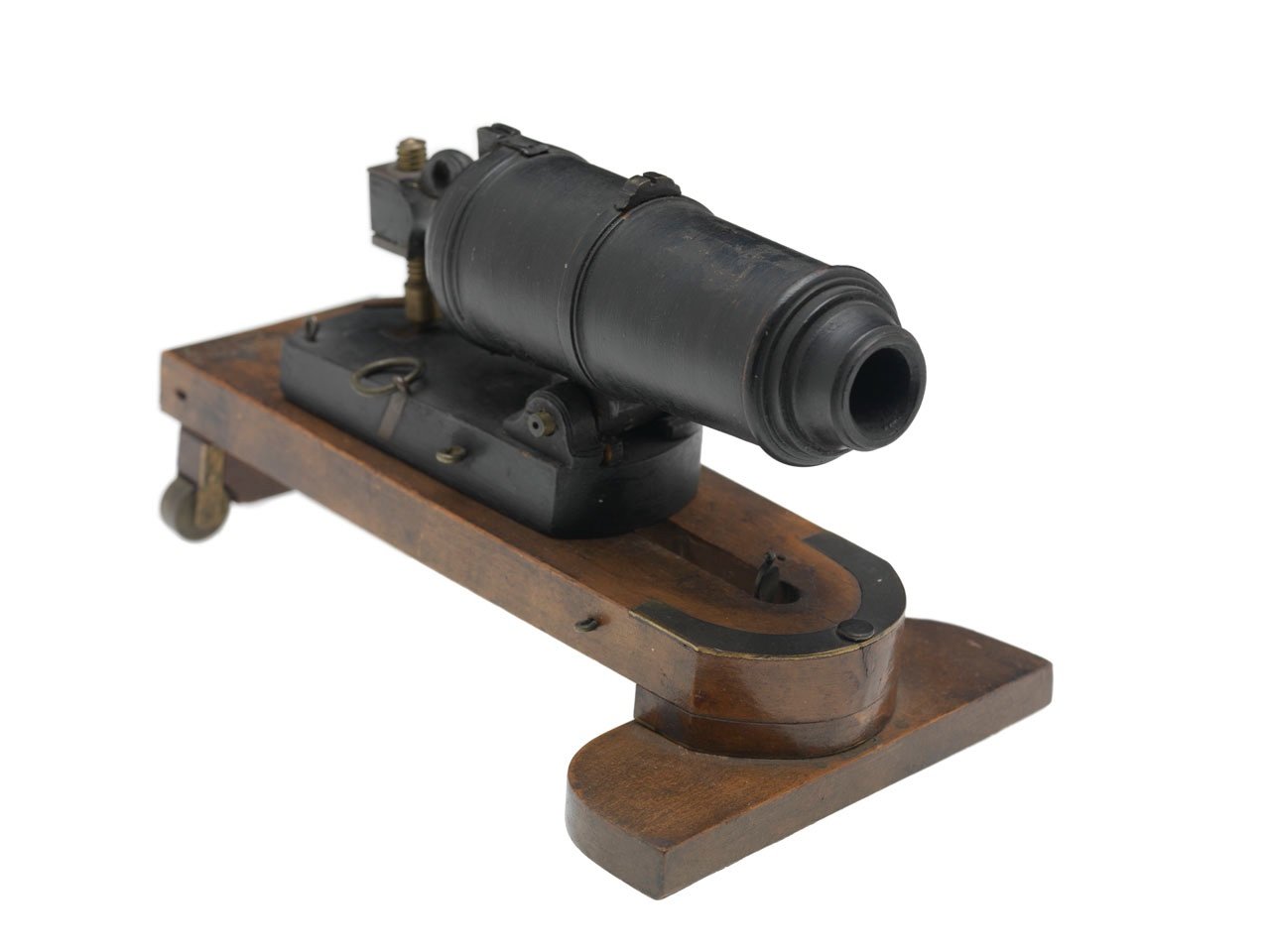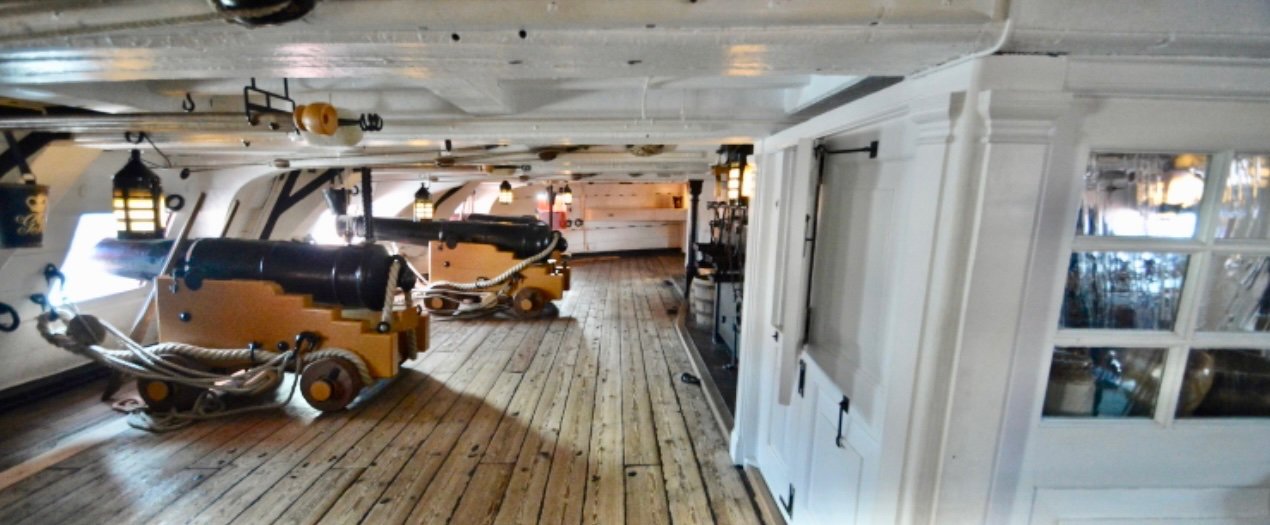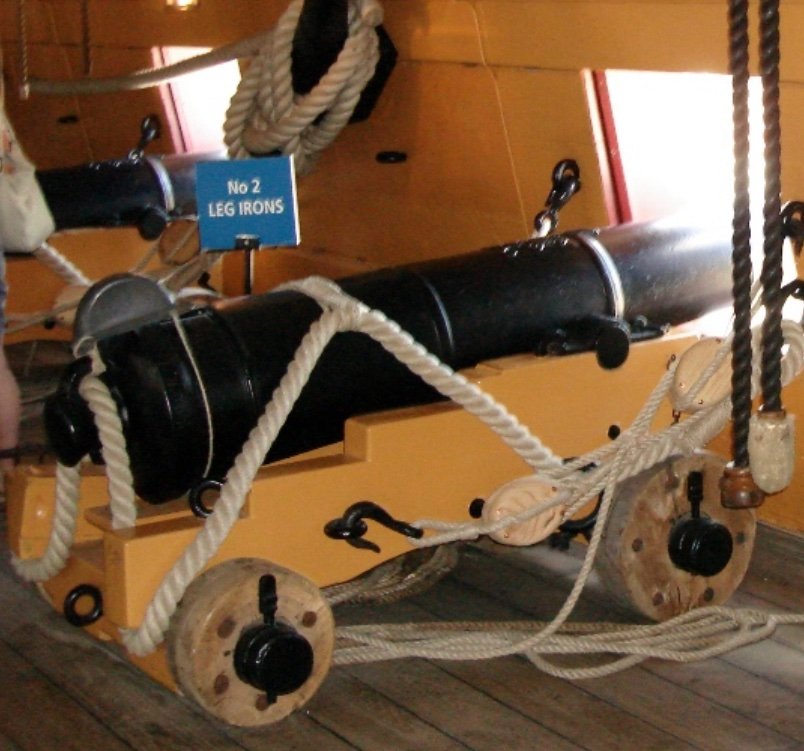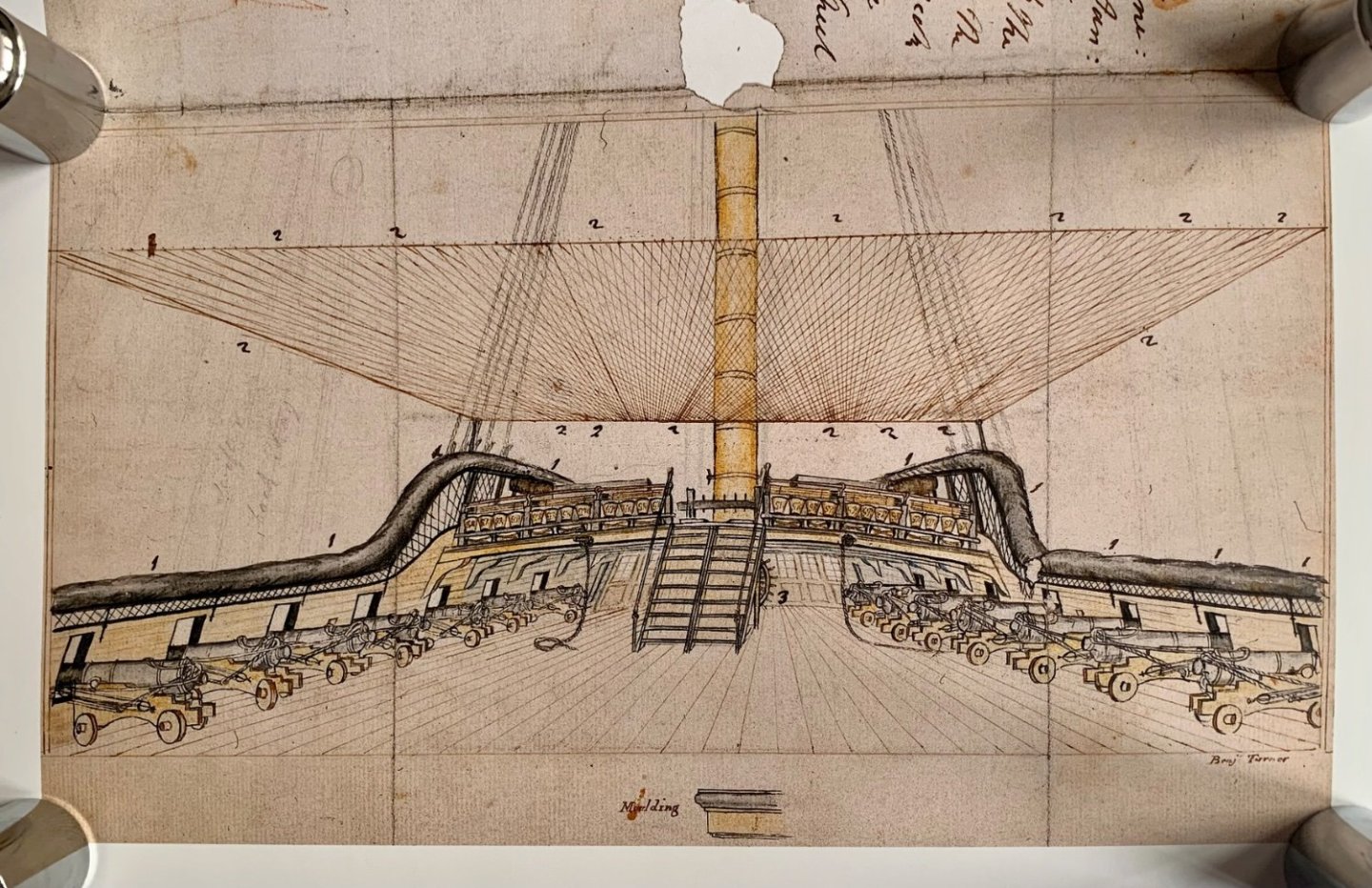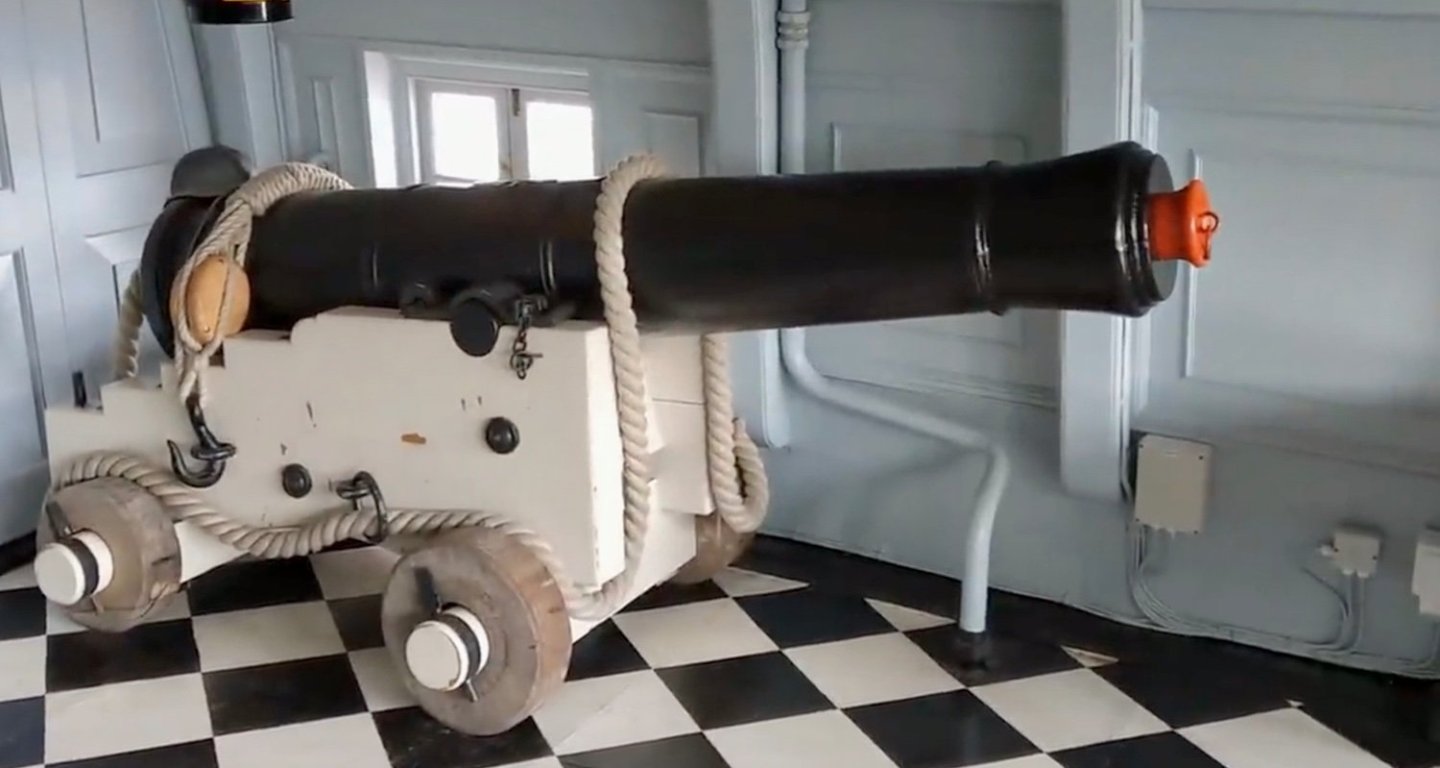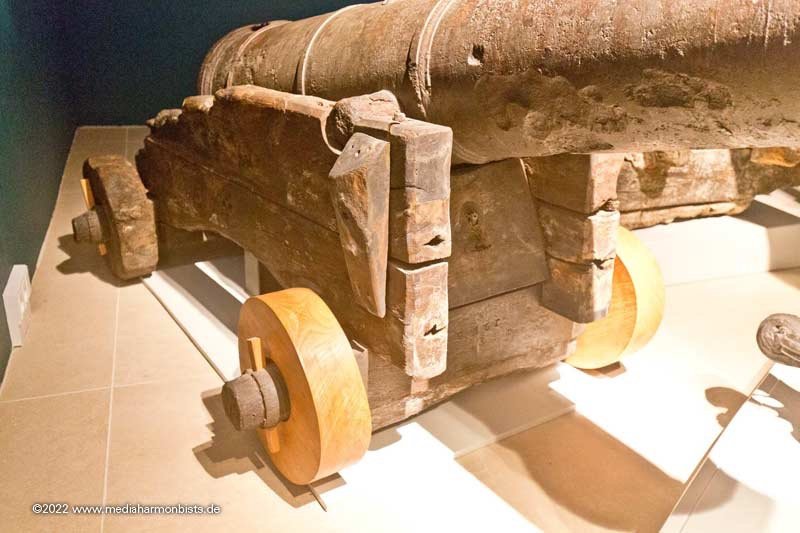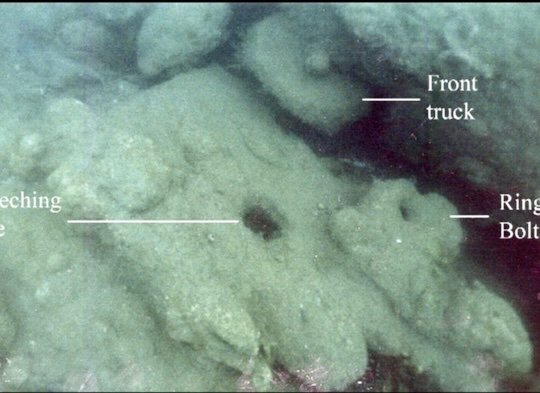-
Posts
546 -
Joined
-
Last visited
Content Type
Profiles
Forums
Gallery
Events
Everything posted by Morgan
-
Hi Richard, It is difficult to know what to make of the accuracy of this watercolour, there are some good and bad points. For instance the gunports seem vertically elongated, more to starboard than port, then the sloped hances seem out of place, they are usually squared off at this time (1799). But there are nice details concerning the sauve tete netting. The guns should be 9-Pounders, and they are low in the port, is this accurate or just poor draughtsmanship? The guns being centre to the ports I picked up from Peter Goodwin, a former Keeper and Curator of HMS Victory, who recorded in an interview for ‘Shipwright 2011’ at page 13 that: “When the work was undertaken to restore the ship in 1922, the only gun carriages available at the time would have been those that were from land-based installations. So most of the gun carriages that were put on the ship, and then copied, were 1845 land-battened carriages. I realised that although to the generals eye it’s a gun carriage, the guns did not fit square and central to the ports. So having done some calculations based on those carriages and then looking at the calculations from Muller’s Treatise on Artillery of 1782 we redesigned the gun carriages as sea service carriages, which are different”. He repeats this observation in some of his later publications pointing to low guns. But there is another reason. Centring the gun to the port both horizontally and vertically ensures that the chance of the gun hitting the port on recoil, when it can jump or kick, is minimised. Then there is the point that when housed within a gunport that requires the gun to remain inboard, then the method of housing is to haul the gun up against the upper sill of the gunport, with the quoins removed so that the breech rested on the stool. The whole design of the ensemble of gun, carriage, port opening size, and height of upper sill eyebolts are such that this enables them to come together with maximum points of contact and facilitate a secure housing. A gun that does not fit centrally to the port will see it not meet all these points of contact and thereby produce a weak and unsafe housing of the gun. A low gun will fail to place the muzzle alongside the upper sill eyebolts and produce a weak muzzle lashing, a high gun will see that the breech does not rest on the stool bed meaning the breech securing is weakened. Of course not all guns were housed inboard, on the quarterdeck they could be housed run-out, and within the Captains apartments they could be fitted with sashes that closed around the gun leaving it run out. This would explain the absence in the watercolour of sill eyebolts, sashes and half ports didn’t need these, but, they were still usually centred to the port. I think the draughtsman's perspective is suspect. Gary
-
Allan, I think this fits what you are seeing. The inner pin locks the bottom two pieces together - I imagine there is some metalwork to accomplish this represented by the broken lines, and the slide pivots on the outer pin. RMG Ref: SLR2918. I think the metal bracket underneath is part of the locking mechanism, if that is removed the Carronade can be swung inboard and stowed along the ships side. The bottom baulk would be permanently fixed to the ships frames. Gary
-
Hi Keith, I agree, these are what I’m used to seeing around historic fortifications in the UK. It is Goodwin who terms them Garrison carriages, I’ll dig out the reference, but he basically says this was the pattern they had and copied as they didn’t have surviving examples of sea service carriages. He doesn’t say they were reused carriages. It could be that in using them as a pattern they knew the iron trucks were wrong and came up with their own version, or copies of a later version of composite trucks they had access to, perhaps off something like Warrior which I imagine needed a heavier truck for 68-Pounders. What Goodwin doesn’t do in saying this is when the carriages were made, it had to be no later than Edwardian based on photographic evidence. So possibly something of a chimera. You can certainly see that the carriage above from 2006 simply doesn’t fit the port, so something was wrong. Goodwin also mentions that during his tenure they were progressively retrofitting the carriages to make them more akin to sea carriages, which I can see when I look back at photos from different visits. Gary
-
I can answer my own question, photo below from 2017 showing 24-Pounders with single piece trucks. There was only 6 Cwt. Weight difference between a 24 and a 32-Pounder, so it seems the size of ordnance isn’t the driver for composite trucks and it comes down to them being land or sea going carriages, certainly in the early 19th century. Gary
-
I did wonder about that, and I also thought perhaps it relates to size of gun, but then I looked back at some photos I took in 2006 of the Upper Deck and some of the 12-Pounder garrison carriages, they also had composite trucks back then. You can see how low the gun is sat! I get the impression that the composite trucks are being swapped out gradually. I could do with some middle and lower deck pictures to see if this applies to the larger pieces. Gary
-
I think Druxey is correct, I have come to the same conclusion. Early 20th century photos of Victory show made-up trucks, but the carriages on Victory at this time were not sea service carriages, none of them actually centre the guns, they were modified garrison carriages. But, as with so many things Victory is taken as the ‘benchmark’, but many details are incorrect, but these errors perpetuate. Many of these carriages are still in Victory. Not all Victory’s guns have built-up trucks, below is a recent photo I took of a 12-Pounder, with single piece trucks. Also, a truck recovered from the wreck of the St. George, she went in for refit just after Victory, so a strict contemporary, is single piece (photo courtesy of Dafi). Also see the attached the drawing of the Venerable from 1799, again single piece trucks. I also visited the wreck of the Invincible exhibition at the NMRN Hartlepool recently and I’m certain there were single piece trucks, I need to download my camera. Gary
-
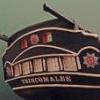
2023 Donations drive
Morgan replied to James H's topic in Using the MSW forum - **NO MODELING CONTENT IN THIS SUB-FORUM**
Done my bit, who’s next? 🙂 -
Hi Patrick, Have a look at the Flota nets micromaster.co.nz produce, they are well detailed and give you an idea of what you are aiming for. Or you could take a shortcut and just order some 😉 - I have no affiliation, I just like their products. Gary
-
Hi BE, Your planking is too good to be covered up. At this stage can you say the coppering would be better and that you will be as satisfied with it as the planking? DON’T DO IT! Having said that knowing when to leave it alone is a hard call, but it is yours to make. I also happen to think if you are presenting it in the Georgian model style without masts, minimal painting, etc. then again without copper works better. Gary
- 648 replies
-
- Indefatigable
- Vanguard Models
-
(and 1 more)
Tagged with:
-
Hi Patrick, I have the Hood 1/200 and Pontos detail set in hand, if they are similar then there should be enough PE replacements to allow all moulded portholes and doors to be replaced. I’m afraid the instructions across their range aren’t great so you need to carefully plan each step in advance including dry fitting so as not to box yourself into a corner. Gary
-
On the subject of teeth, a common Victorian practice in the UK was for a brides father to pay for his daughters teeth to be extracted and replaced with dentures, even if her teeth were perfect. This wedding gift was to save the new groom the expense of dental upkeep over her lifetime! And if you couldn’t parcel your daughter off early it was also a perfectly acceptable 21st Birthday present! This practice continued into the 1950’s remaining particularly prevalent in Scotland. As I sit here and reflect on the cost of my Scottish wife’s dental bill over the length of our marriage I can’t help but feel my father in-law in not providing this service has left me with an otherwise avoidable financial burden that could have paid for several good holidays (or more model kits & bits)! Gary
-
Jaager, I entirely echo your thoughts, even though it is uncomfortable in that it challenges the interpretation of the models many of us strive to build, but as you allude to, strongly opinionated personalities often dominate the debate on a given restoration programme, all in order to achieve a preconceived interpretation that they favour which masks a more accurate interpretation. One case I have looked into extensively is that of the Victory. The artist WL Wyllie was a leading figure in the drive to restore the Victory to her Trafalgar condition, he was an outspoken individual and in many respects a self-declared expert. In 1905 he exhibited his ‘Panorama of Trafalgar, of which Arthur Bugler in his ‘H.M.S. Victory: Building, restoration and repair’ was to say some 60 years later that “it is remarkable that the VICTORY of the painting was in the main faithfully portrayed as she was finally restored in 1929”. Somehow Wyllie was able to forecast the appearance of Victory 20 years prior to her restoration, how prescient! Yet, the investigations into what Victory looked like were not undertaken until 1923, by LG Carr Laughton, at the outset of the restoration, which spanned the years 1922 – 1928. Wyllie certainly took in Sir Philip Watts who had ‘been appointed by the Society for Nautical Research to act as chairman of a Sub-Committee to consider what steps shall be taken to preserve the ship and to restore her approximately to her condition at the Battle of Trafalgar’. Watts was to record in April 1923 in [The] Mariner’s Mirror in an article entitled ‘Notes on the Preservation of H.M.S. “Victory” and her Restoration to the Trafalgar Condition’ that “She had originally a most beautiful bow and stern, much admired and beloved by all marine artists (who would that be 😏) Some of the beauty still remains, but much has disappeared as the results of changes made from time to time. It is necessary that the original beauty of the bow and stern shall be restored, and this shall be one of the first works of restoration”. Wyllie had a vision and not a Time Machine, and he pushed it through, this was ostensibly to revert Victory to her 1765 appearance, which Watts dutifully echoed. Fortunately, the advisory technical committee could not ignore all the work of LG Carr Laughton and had to concede on matters such as the figurehead and stern, but much of Wyllie’s interpretation lingers in the present Victory despite evidence to the contrary. In part, even nowadays, many ‘respected’ historians, who are often cited in threads on this site, are guilty of pedalling and repeating incorrect facts, some of which are quite fundamental to interpreting certainly what the Victory and Trincomalee looked like. These ‘experts’ have demonstrably failed to check the primary sources for themselves. Having spent many hours at the UK’s National Archives, British Library, National Museum of the Royal Navy, etc. looking into the source documents leads me to very different descriptions drawn directly from primary sources, these sources don’t need interpretation, they are unequivocally clear. NAM Rodger in his ‘The Command of the Ocean: A Naval History of Britain, 1649 - 1815’, puts it as follows “The ultimate view of an indignant historian is profit .... It is not expected that he will consume his years in laborious researchers after truth. His subsistence depends on the immediate sale of his labours. Hence he complies in haste the errors and contradictions of former historians, and perpetuates error from want of time to investigate truth.” My advice to those who want authenticity in their models, even in respect of the subjects thought to be well documented, is go check the source documents for yourselves if you can, don’t rely on the ship as evidence if it still survives, or artists interpretations who cannot have seen the subject for themselves firsthand at the time at which it is said to have been portrayed. Gary
-
Hi Michael, The beams were jacked up to allow the columns to be removed, common practice when using the capstan or clearing for action. Gary
- 60 replies
-
- Agamemnon
- Ardent-class
-
(and 2 more)
Tagged with:
-
The definition at that scale isn’t great but they look like the mushroom vents that Hood had, later British ships had square vents. Gary
-
She’s had more refits and reconstructions than the real ship 😁 But nice work all the same. Gary
-

Archaeological Evidence for the Development of RN Gunnery
Morgan replied to Steve20's topic in Nautical/Naval History
Hi Steve, One issue I had with Steven’s essay when I last looked at it is the chronology, he talks of Captain Elliot’s concentration of fire in Victory using sweep pieces, but Elliot commanded Victory in the 1820’s when she was a guard ship with very few guns, so some doubts as to attribution, but notwithstanding it points to a continuity of sweep pieces from the time of Colossus. In terms of deck storage of shot in my view it was confined to the shot racks around the coamings, in rough weather the hatches were covered in canvas and fixed with battens, these could easily have extended to cover the shot racks and pin the shot in place. The 16-hole shot holder from St Gorge was probably a temporary holder used in action. If you take Victory prior to Trafalgar she brought 3,000 shot up to the decks before the battle. These holders are what were deployed around the deck. It is not clear if they were stacked in tiers upon them. They would have been stored when in use wherever was convenient that did not interfere with the running of the ship. Shot were gotten out of the hold using woven baskets and hoisted to each deck from the hold. Gary -

Archaeological Evidence for the Development of RN Gunnery
Morgan replied to Steve20's topic in Nautical/Naval History
I note the above discussion ranges from the Hazardous to the St. George, given there is a century between these wrecks I doubt a comparison of shot storage and handling can be readily made. Things changed tremendously over the course of the 18th Century for the Royal Navy, it went from a gentleman officer class who left much to the warrant officers, to a meritocracy where officers involved themselves in many professional spheres such as ship design, cartography, gunnery, engineering, etc. But in many respects it was the small incremental changes over this century in particular, such as in shot storage and handling as an example that set it apart from its continental rivals. Daniel Pascoe’s work tries to address this development, but the fact that there is this debate shows he achieved no definitive answer. Gary -
I don’t think there is a single use for the upper ring bolts, they were in my view multi-functional as described in the various posts above. They were an alternate out-haul tackle position and back-up to the lower rings in case of eye bolt failure. They could in other circumstances be the primary out-haul tackle points when the lower rear eyes were used for lateral training. In other circumstances when an additional secondary or preventer breaching rope was used they elevated the outhaul tackle above the two breaching ropes to prevent them fouling one another. There is probably more unwritten about what sailors in those days could achieve with a few blocks and tackle than we will ever know, they were practical men and we shouldn’t underestimate the breadth of their solution based approach to such matters just because no one wrote it down. Gary
-

HMS Victory Renovation - Outer Planking Removed
Morgan replied to Steve20's topic in Nautical/Naval History
Hi Steve, I’ve been looking at the historic record on Victory for a decade now, I really need to get a different hobby! It is surprising as to how little there is published on Victory, literally just a hand full of books, some of them quite bad I’m afraid. In contrast with Nelson and Trafalgar you could fill a library, but I’m afraid 95% of it is the same. To understand how Victory has changed I would recommend starting with ‘H.M.S. VICTORY REPORT TO THE VICTORY TECHNICAL COMMITTEE OF A SEARCH AMONG THE ADMIRALTY RECORDS’ by LG Carr Laughton, published in the Marriner's Mirror, even though a hundred years old much of it is still relevant. Unfortunately there are no detailed records of Victory’s 1920’s restoration, it was a simple case of rip it out and re-build it, no thought for archaeological processes I’m afraid. Next on the list sequentially is Arthur Bugler in 1966 with his ‘HMS Victory; Building, restoration, and repair’. Quite a comprehensive work and it details some of the 1920’s work and brings it up to date for 1966. Next in line, chronologically, is Alan McGowan’s ‘HMS Victory; Her Construction, Career, and Restoration’. He brings the restoration story up to date in 1999. His restoration update is good, but his historical analysis is lacking in primary research. Next in line, is the HMS Victory Conservation Management plan, I see you have part 1, there is a Part 2. This brings the story up to date, but beware the Wessex Archaeology caveats, they have accepted the work of others historically as given. Taken together the last 3 publications detail the structural modifications, the primary reference is by ‘Station’, the stations are the individual frames running sequentially from Bow to Stern, and I believe there is enough information in the 3 volumes to plot the timeframe in which frames were replaced. If you attempt this it should keep you busy for a while. Gary -

HMS Victory Renovation - Outer Planking Removed
Morgan replied to Steve20's topic in Nautical/Naval History
Most of the frames at this level in the structure are 20th Century, I would suggest the older looking frames are from the 1920’s restoration and the newer from c.1960 onwards. If you want to narrow it down I can point you as to where the raw information can be found, but you will need some spare time to collate it 😁. I’d have a go myself but the sun is out and lethargy has kicked in ☀️ 🌞 😎, I forecast it could last for a while (or at least until the Admiral issues new standing orders!). Gary
About us
Modelshipworld - Advancing Ship Modeling through Research
SSL Secured
Your security is important for us so this Website is SSL-Secured
NRG Mailing Address
Nautical Research Guild
237 South Lincoln Street
Westmont IL, 60559-1917
Model Ship World ® and the MSW logo are Registered Trademarks, and belong to the Nautical Research Guild (United States Patent and Trademark Office: No. 6,929,264 & No. 6,929,274, registered Dec. 20, 2022)
Helpful Links
About the NRG
If you enjoy building ship models that are historically accurate as well as beautiful, then The Nautical Research Guild (NRG) is just right for you.
The Guild is a non-profit educational organization whose mission is to “Advance Ship Modeling Through Research”. We provide support to our members in their efforts to raise the quality of their model ships.
The Nautical Research Guild has published our world-renowned quarterly magazine, The Nautical Research Journal, since 1955. The pages of the Journal are full of articles by accomplished ship modelers who show you how they create those exquisite details on their models, and by maritime historians who show you the correct details to build. The Journal is available in both print and digital editions. Go to the NRG web site (www.thenrg.org) to download a complimentary digital copy of the Journal. The NRG also publishes plan sets, books and compilations of back issues of the Journal and the former Ships in Scale and Model Ship Builder magazines.



